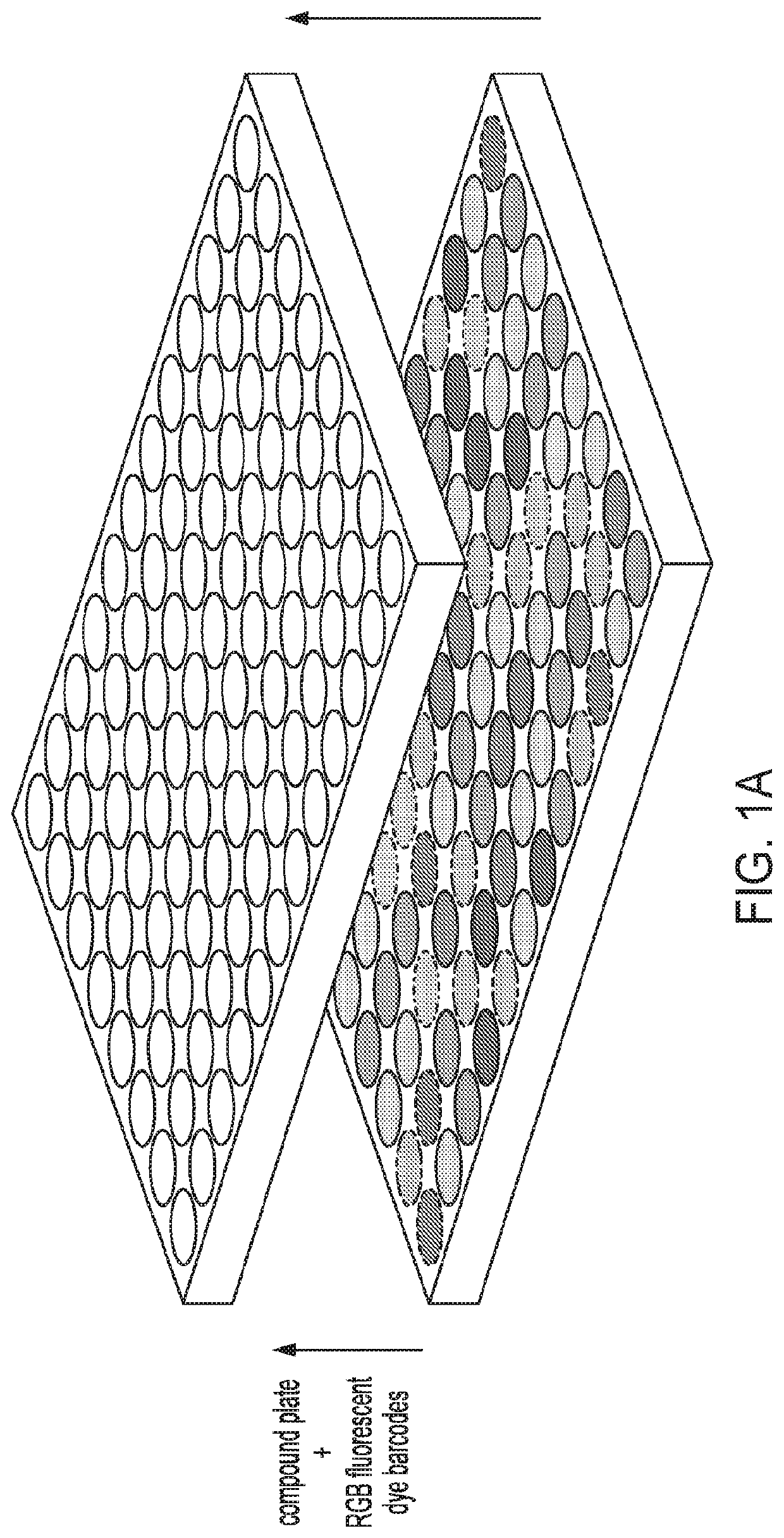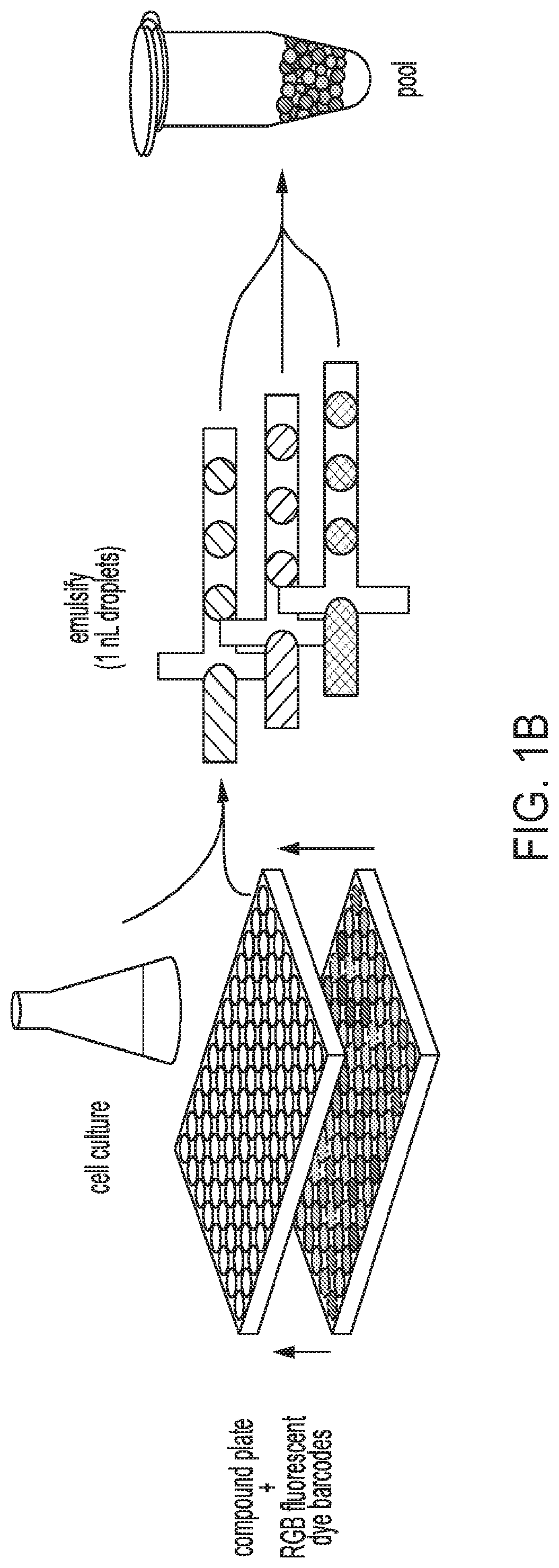Compositions and methods for combinatorial drug discovery in nanoliter droplets
a technology of nanoliter droplets and compounds, applied in the direction of antibacterial agents, peptides/protein ingredients, peptides, etc., can solve the problems of prohibitive costs and complexity, slowed identification of novel drug combinations for combination therapy, and limited specialized labs and facilities for experiments of this scale, so as to reduce the frequency or severity of pathological symptoms, reduce the frequency or eliminate the bacterial infection, the effect of reducing the frequency of the pathological
- Summary
- Abstract
- Description
- Claims
- Application Information
AI Technical Summary
Benefits of technology
Problems solved by technology
Method used
Image
Examples
example 1
[0305]The techniques herein provide a strategy for combinatorial drug screening based on parallel droplet processing. This processing strategy makes order of magnitude improvements in logistical complexity, compound consumption, and demand for capital equipment (FIG. 1H). Recent advances in droplet microfluidics and molecular barcoding are making a major impact in genomics for processing cells and nucleic acid molecules in high speed serial streams of water-in-oil emulsion droplets. With the disclosed processing strategy, parallel handling millions of droplets reaches the scale needed for combinatorial screening. Additionally, the droplets' nanoliter volume reduces compound consumption required for screening. The present disclosure incorporates optical barcodes and parallel manipulation of droplets in large fixed-position spatial arrays to link droplet identity with assay results. A unique advantage of the present system is the parsimonious use of the compounds screened in the 2 nL ...
example 2
[0309]As a first application of the platform, fluorescence-based, growth inhibition phenotypic screening assays, were developed for the three model organisms, bacterial pathogens most often used in antibiotic discovery, Staphylococcus aureus, Pseudomonas aeruginosa, and Escherichia coli. For each organism, a comparison of growth rates (FIG. 2B, FIG. 2H), antibiotic drug responses (FIG. 2C, FIG. 2I, FIG. 2K, and FIGS. 23-25), and data quality of the microdroplet system with conventional Erlenmeyer flask and microplate broth culture methods were performed (FIG. 2D, FIG. 2I, FIG. 2J, FIG. 2K). In embodiments, growth measurements were determined by measurement of constitutively expressed GFP rates. For example, P. aeruginosa cultured on the disclosed platform showed a GFP doubling time of 56+ / −5 min on the platform, compared to 62+ / −3 min in an Erlenmeyer flask, and other organisms showed similar comparability (FIG. 2B, FIGS. 26A-26C).
[0310]The platform faithfully recapitulates growth c...
example 3
[0313]The system was then applied to identify compounds that can potentiate the activity of antibiotic drugs. In the face of rising antibiotic resistance, efforts to develop new types of antibiotics have yielded little success. However, many existing antibiotics such as vancomycin, erythromycin, and novobiocin, cannot be used to treat important Gram-negative pathogens such as E. coli, P. aeruginosa, and A. baumannii, due to their impermeable outer membranes. Coupling drugs developed for other indications with these antibiotics to overcome this intrinsic resistance could have a more rapid clinical impact at lower costs than de novo discovery, but discovery is limited by the combinatorial complexity and compound consumption of screening larger numbers of drug-antibiotic combinations.
[0314]Experiments screened for potentiation of a panel of 10 antibiotics (FIG. 10A) with diverse mechanisms at three different combinations and biochemical target locations by a “drug repurposing” library ...
PUM
| Property | Measurement | Unit |
|---|---|---|
| size | aaaaa | aaaaa |
| size | aaaaa | aaaaa |
| concentration | aaaaa | aaaaa |
Abstract
Description
Claims
Application Information
 Login to View More
Login to View More - R&D
- Intellectual Property
- Life Sciences
- Materials
- Tech Scout
- Unparalleled Data Quality
- Higher Quality Content
- 60% Fewer Hallucinations
Browse by: Latest US Patents, China's latest patents, Technical Efficacy Thesaurus, Application Domain, Technology Topic, Popular Technical Reports.
© 2025 PatSnap. All rights reserved.Legal|Privacy policy|Modern Slavery Act Transparency Statement|Sitemap|About US| Contact US: help@patsnap.com



